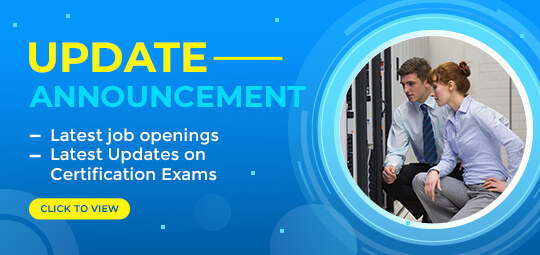TRUSTED BY THE SMARTEST TEAMS IN THE WORLD FOR CERTIFIED CANDIDATES
SPOTO Blogs
Useful learning materials to become certified IT personnel
-
- 938
- circle
- 2025-04-08 11:27
-
- 924
- circle
- 2025-04-08 10:56
-
- 1373
- circle
- 2025-04-07 11:48
-
- 1183
- circle
- 2025-04-07 11:21
-
- 1133
- circle
- 2025-04-03 11:49
-
- 1191
- circle
- 2025-04-03 11:20
-
- 1099
- circle
- 2025-04-02 14:46
-
- 1267
- circle
- 2025-04-02 14:26
-
- 1185
- circle
- 2025-04-01 14:53
TRUSTED BY THE SMARTEST TEAMS IN THE WORLD FOR CERTIFIED CANDIDATES
SPOTO Blogs
Useful learning materials to become certified IT personnel
-
- 938
- circle
- 2025-04-08 11:27
The Palo Alto Networks Certified Network Security Engineer (PCNSE) certification is a top-tier credential for cybersecurity professionals aiming to demonstrate their expertise in Palo Alto Networks technologies. While it's a valuable certification, it's also known for its challenging content and real-world scenarios. Many candidates find specific sections of the exam especially tough. So, how do you navigate these tricky parts and come out successful? Let's dive into the most difficult areas of the PCNSE and how to master them. 1. Panorama Management: Don't Just Memorize—Understand Why it's hard: Panorama centralizes management of multiple firewalls, but its setup, templates, device groups, and shared policies can be confusing. Many candidates struggle to understand how changes cascade across multiple devices. Tip: Spend hands-on time using Panorama in a lab. Learn how templates apply configurations to managed devices and how device groups organize policy rules. Practice pushing changes and troubleshooting sync issues. Don't just memorize where buttons are—understand how Panorama fits into a real-world enterprise deployment. 2. Security Policies and App-ID: Know the Logic Why it's hard: Security policies in Palo Alto firewalls are rule-based and deeply tied to App-ID, which identifies applications rather than relying solely on ports and protocols. Understanding how App-ID, user-ID, and content-ID all come together in policy enforcement can get overwhelming. Tip: Use the CLI and GUI to analyze traffic logs and see how policies match. Pay attention to rule ordering, shadowed rules, and how App-ID dynamically adjusts during a session. Practice tuning security profiles for malware and URL filtering within policies. Knowing how to read traffic logs is key to troubleshooting issues. 3. NAT Rules and Route-Based VPNs: Lab, Lab, Lab Why it's hard: NAT configurations and VPN setups can be complex, especially when layered on top of each other. Route-based VPNs using tunnel interfaces often confuse candidates new to networking. Tip: Build a lab with two firewalls and create site-to-site VPNs using tunnel interfaces. Experiment with static, dynamic, and policy-based NAT. Understand the difference between pre-NAT and post-NAT addresses and how NAT interacts with security policies and routing. The only way to truly master this is through hands-on practice. 4. Decryption and SSL Inspection: Handle With Care Why it's hard: Decryption introduces privacy, compliance, and technical challenges. Many candidates struggle to configure SSL Forward Proxy and SSL Inbound Inspection correctly, especially when dealing with certificates. Tip: Focus on the decryption policy structure and understand how certificates are generated and trusted. Practice installing enterprise CA certificates and troubleshooting certificate errors on client browsers. Remember, decryption policies require both technical skill and an understanding of business implications. 5. Troubleshooting and Log Analysis: Think Like a Detective Why it's hard: The exam is heavy on troubleshooting scenarios where you must interpret logs and pinpoint misconfigurations or behavioral issues. These questions test your ability to think critically and apply knowledge, not just recall facts. Tip: Get familiar with the Monitor tab and learn how to dissect traffic, threat, and system logs. Understand the sequence of traffic flow—how a session is built, inspected, and acted upon. Use CLI commands like show session all, debug dataplane, and less mp-log to simulate real-world debugging. Extra Tips for Success Practice with real devices or virtual firewalls: Palo Alto Networks offers virtual machines for lab use. You can build networks, simulate traffic, and fine-tune your skills. Use official documentation and whitepapers: These resources are goldmines of detailed explanations, especially on niche topics like QoS or User-ID integration. Focus on scenario-based learning: PCNSE isn't about rote memorization. Build problem-solving habits that mirror real job duties. Don't neglect the cloud components: Features like Prisma Access and GlobalProtect are increasingly important and show up in the exam. Final Thoughts The PCNSE exam is a serious challenge, but the payoff is equally significant. It sharpens your real-world skills, strengthens your cybersecurity resume, and proves that you can manage complex network security environments using Palo Alto Networks tools. Focus on hands-on practice, especially in the areas mentioned above, and you'll be well on your way to success. Remember, the toughest topics often lead to the biggest breakthroughs. Stay persistent, and don't just aim to pass the exam—aim to understand the platform inside and out. -
- 924
- circle
- 2025-04-08 10:56
The Project Management Professional (PMP) certification is one of the most prestigious and globally recognized credentials in the world of project management. Offered by the Project Management Institute (PMI), it validates your ability to lead and direct projects across different industries. One of the most common questions aspiring PMPs ask is: Can I pass the PMP exam through self-study alone? The short answer? Yes, it's possible—but it depends on a few key factors. Understanding the PMP Exam Structure Before deciding on your study method, it's essential to understand what the PMP exam entails. The exam tests your knowledge of: People – emphasizing the soft skills needed to effectively lead a project team. Process – focusing on the technical aspects of managing a project. Business Environment – highlighting the connection between projects and organizational strategy. It consists of 180 questions (multiple-choice, multiple responses, matching, and hotspot), which are scenario-based, requiring you to apply principles rather than recall facts. When Self-Study Can Work 1. You're an Experienced Project Manager If you already meet the PMP eligibility requirements (e.g., 3-5 years of project management experience), you likely have a good foundation in many of the concepts tested on the exam. Self-study might be enough to fill in knowledge gaps and align your experience with the PMI framework. 2. You're Self-Motivated and Disciplined Self-study demands a high level of commitment and time management. You'll need to create a schedule, stick to it, and ensure you're reviewing all the key areas of the exam outline. Without a structured classroom environment, staying focused is entirely up to you. 3. You Use the Right Resources Success in self-study hinges on using reliable and comprehensive materials. At minimum, you'll need: The PMBOK Guide (currently the 7th Edition) A reputable PMP exam prep book (e.g., Rita Mulcahy's PMP Exam Prep) Online courses or video lectures PMP exam simulators or practice tests These resources will help you understand not just what to study, but how to study effectively for the PMP exam. Advantages of Self-Study Flexible schedule: You can study at your own pace, around your work and personal life. Cost-effective: Self-study can be significantly cheaper than instructor-led training or bootcamps. Customized approach: You can focus more on your weak areas and skip what you already know. Challenges of Self-Study No real-time guidance: If you hit a tough concept, you're on your own unless you seek help from online communities. Time-consuming: Without a teacher or deadlines, it might take longer to prepare. Lack of accountability: It's easier to procrastinate or lose momentum without structured support. Tips to Succeed With Self-Study Follow a Study Plan: Break down the exam content outline into weekly goals. Allocate time for reading, practice questions, and review. Take Practice Exams: Use mock tests to simulate the real exam environment. Aim to consistently score 75–80% before booking the real exam. Join Online Communities: Platforms like Reddit, LinkedIn groups, or PMI forums are full of PMP candidates and certified professionals willing to share tips, clarify doubts, and offer moral support. Use Flashcards and Notes: Reinforce your memory of key concepts, formulas, and terminologies with digital or physical flashcards. Don't Skip the Agile Content: The PMP exam now includes a significant number of questions related to Agile and hybrid methodologies. Make sure to study frameworks like Scrum, Kanban, and SAFe. When Self-Study May Not Be Enough Self-study might not be the best route if: You're completely new to project management. You struggle with motivation or focus. You learn better through interaction and real-time discussion. You need the 35 contact hours of project management education and don't already have them. In such cases, enrolling in a PMP prep course or bootcamp may provide the structure and support needed to pass the exam efficiently. Final Verdict Self-study can be enough to pass the PMP certification, but it requires a strategic approach, reliable resources, and serious commitment. Many candidates have successfully earned their PMP credentials by studying independently. If you're experienced, disciplined, and proactive about using diverse study tools, you can absolutely join their ranks. Remember: the key is not just studying hard, but studying smart. With the right mindset and a well-planned approach, self-study could be your ticket to PMP success. -
- 1373
- circle
- 2025-04-07 11:48
The Palo Alto Networks Certified Network Security Engineer (PCNSE) certification is a respected credential that validates your knowledge of Palo Alto Networks technologies and your ability to design, deploy, configure, maintain, and troubleshoot the vast majority of implementations based on the Palo Alto Networks platform. If you're serious about becoming a cybersecurity pro with a focus on network security, earning the PCNSE is a smart move. Here's a step-by-step guide to help you master the PCNSE certification. Step 1: Understand What PCNSE Is All About Before diving into study mode, understand what the certification entails. The PCNSE exam tests your knowledge of core features and functions of Palo Alto Networks next-generation firewalls, Panorama, and associated security technologies. Knowing what the exam covers helps you prepare smarter. Step 2: Review the Official Exam Blueprint Visit the official Palo Alto Networks certification website and download the PCNSE exam blueprint. This document outlines the exact topics and weightage of each domain. Focus your efforts based on the blueprint to ensure you're not wasting time on irrelevant topics. Step 3: Get Hands-On with Palo Alto Firewalls Theory is important, but the PCNSE exam is deeply rooted in practical knowledge. Set up a lab environment using virtual firewalls (VM-Series) or use Palo Alto's online lab resources if available. Practice configuring interfaces, security policies, NAT rules, and user ID features. Step 4: Take the EDU-210 Course (If You Can) While not mandatory, Palo Alto's EDU-210 course (Firewall Essentials: Configuration and Management) offers a great introduction to the firewall platform. If your organization provides access, or you can invest in it yourself, this course lays a strong foundation. Step 5: Use Multiple Study Resources Don't rely on a single book or video series. Combine official documentation, community discussions, practice questions, and video courses (from platforms like Udemy, LinkedIn Learning, SPOTO, or CBT Nuggets) to reinforce your knowledge from different angles. Step 6: Practice with Real-World Scenarios Try to simulate real-world scenarios in your lab. For example, configure site-to-site VPNs, troubleshoot routing issues, and apply security profiles to policies. The more familiar you are with practical tasks, the more confident you'll be during the exam. Step 7: Focus on Panorama and Cloud Integration PCNSE isn't just about firewalls. Panorama, Palo Alto's centralized management solution, plays a significant role in the exam. Make sure you can configure and manage devices via Panorama, and don't overlook cloud-delivered security features like Prisma Access. Step 8: Join Online Communities Join forums and social media groups dedicated to Palo Alto Networks certifications. Reddit, LinkedIn groups, and sites like Live Community are great places to ask questions, get tips from certified professionals, and stay up to date with exam changes. Step 9: Take Practice Exams Mock exams are one of the best ways to gauge your readiness. Aim to consistently score above 80% before you sit the real exam. Analyze your incorrect answers carefully to understand your weak points and revisit those topics. Step 10: Schedule and Sit for the Exam Once you feel confident in your preparation, go ahead and schedule your PCNSE exam through Pearson VUE. Make sure to get a good night's rest, stay calm, and trust your preparation. Final Thoughts Mastering the PCNSE certification takes dedication, hands-on practice, and a strategic study plan. By following these ten steps, you'll be well-equipped to pass the exam and advance your career as a network security engineer. The investment of time and effort will pay off, giving you industry recognition and opening doors to higher-level security roles. Stay consistent, stay curious, and you'll be a PCNSE in no time. -
- 1183
- circle
- 2025-04-07 11:21
In today's cloud-driven tech landscape, the demand for skilled professionals who can manage and maintain cloud environments is rapidly increasing. One of the most recognized certifications in this space is the Microsoft Certified: Azure Administrator Associate. This credential not only validates your expertise in managing Azure resources but also positions you for lucrative and in-demand roles across industries. If you're looking to establish or grow your cloud career, understanding this certification's details and benefits is essential. What Is the Microsoft Azure Administrator Certification? The Azure Administrator Certification (Exam AZ-104) is designed for IT professionals who implement, monitor, and maintain Microsoft Azure solutions. This includes managing Azure subscriptions, securing identities, administering infrastructure, configuring virtual networks, and more. The certification focuses on real-world tasks that an Azure administrator handles daily. It covers: Managing Azure identities and governance Implementing and managing storage Deploying and managing Azure compute resources Configuring and managing virtual networking Monitoring and backing up Azure resources Passing the AZ-104 exam earns you the Microsoft Certified: Azure Administrator Associate badge, a globally respected credential. Who Should Consider This Certification? This certification is ideal for: IT professionals who manage cloud services in an Azure environment System administrators looking to shift to cloud-based roles Professionals seeking a foundational certification before pursuing more advanced Azure credentials Career switchers entering the cloud computing space While there are no strict prerequisites, having experience with Azure services, general networking knowledge, and familiarity with PowerShell or Azure CLI can be extremely helpful. Key Skills You'll Learn Preparing for the Azure Administrator Certification equips you with a broad range of valuable cloud skills, including: Identity Management: Control access to resources using Azure Active Directory and role-based access control (RBAC). Storage Management: Configure blob storage, file shares, and recovery options. Virtual Machines: Deploy, manage, and optimize virtual machines for cost and performance. Networking: Set up and configure virtual networks, subnets, firewalls, and DNS. Monitoring and Reporting: Use Azure Monitor and log analytics to oversee and optimize resource performance. These skills are not only vital for passing the exam but also directly applicable to day-to-day cloud administration. Benefits of Earning the Certification 1. Career Advancement Certified Azure Administrators are in high demand. According to recent job market trends, employers actively seek professionals with Microsoft Azure skills. This certification validates your ability to manage cloud infrastructure and increases your chances of landing roles such as: Azure Administrator Cloud Systems Engineer Infrastructure Engineer Cloud Support Specialist 2. Higher Salary Potential Holding a Microsoft Azure certification can significantly boost your earning potential. On average, Azure-certified professionals earn more than their non-certified peers. Entry-level roles may start around $70,000 per year, while experienced Azure Administrators can earn upwards of $100,000 annually, depending on location and expertise. 3. Recognition from Employers and Peers Microsoft certifications are globally respected. Earning the Azure Administrator Associate badge shows employers that you're serious about your career and capable of managing complex cloud environments. 4. Foundation for Further Certifications AZ-104 is a prerequisite or recommended starting point for more advanced Azure certifications such as: Designing Microsoft Azure Infrastructure Solutions (AZ-305) Azure Security Engineer Associate (AZ-500) Designing and Implementing Microsoft DevOps Solutions (AZ-400) By earning this credential, you build a strong foundation for further specialization and career growth in cloud computing. 5. Hands-On Knowledge The certification process is hands-on. You'll learn by doing, which means you'll gain real-world skills that translate directly to on-the-job tasks. Many candidates use Azure's free tier or sandbox environments to practice deploying and managing resources. Exam Format and Preparation Tips The AZ-104 exam includes various question types, such as multiple choice, drag and drop, case studies, and scenario-based tasks. You'll need to demonstrate practical knowledge across all exam topics. Preparation Tips: Use Microsoft Learn for structured, official learning paths. Take practice tests to assess your readiness. Set up a lab environment using the Azure free tier. Watch video tutorials and follow along with hands-on exercises. Review the official exam guide regularly. Expect to dedicate around 6–8 weeks of consistent study if you're balancing exam prep with a full-time job. Conclusion The Microsoft Azure Administrator Certification is an excellent stepping stone into the world of cloud computing. It offers a blend of practical skills and industry recognition that can open doors to better jobs, higher salaries, and long-term career growth. Whether you're new to Azure or looking to formalize your experience with a respected credential, this certification is a smart investment in your professional future. Take the first step toward becoming a certified Azure Administrator—your cloud career awaits. -
- 1133
- circle
- 2025-04-03 11:49
If you're looking to advance your career in networking, choosing between Cisco Certified Network Associate (CCNA) and Cisco Certified Network Professional (CCNP) can be a challenging decision. Both certifications offer immense value, but which one aligns best with your career aspirations? Whether you're a beginner stepping into the networking world or an experienced professional looking to specialize, this guide will help you determine the right path for your goals. Understanding CCNA and CCNP What is CCNA? The CCNA (Cisco Certified Network Associate) is an entry-level certification that provides foundational knowledge of networking. It covers essential topics such as: Network fundamentals IP addressing and subnetting Routing and switching concepts Network security basics Automation and programmability CCNA is ideal for those who are new to networking or looking to establish a strong technical foundation. It's a great stepping stone toward more advanced certifications like CCNP. The certification validates your ability to install, configure, operate, and troubleshoot small to medium-sized networks. This makes it a strong choice for individuals starting their journey in IT infrastructure and networking. What is CCNP? The CCNP (Cisco Certified Network Professional) is an advanced certification designed for professionals who want to specialize in networking. It offers multiple concentration tracks, including: CCNP Enterprise – Focuses on routing, switching, SD-WAN, and network automation. CCNP Security – Covers firewall technologies, VPNs, and cybersecurity principles. CCNP Data Center – Deals with data center technologies, virtualization, and automation. CCNP Collaboration – Emphasizes voice, video, and unified communications. CCNP Service Provider – Focuses on carrier-grade networking technologies. Unlike CCNA, CCNP requires a deeper understanding of networking and the ability to configure, troubleshoot, and optimize network environments. CCNP is designed for professionals who want to build expertise in specialized areas of networking, allowing them to handle more complex tasks and take on greater responsibilities within an organization. Who Should Choose CCNA? Best for Beginners If you have little to no experience in networking, CCNA is the perfect starting point. It introduces you to key networking concepts without overwhelming complexity. CCNA is suitable for students, recent graduates, and professionals switching from other industries to IT. It provides a structured learning path and a clear foundation to progress in networking. Ideal for Entry-Level Roles CCNA certification is well-suited for job roles such as: Network Technician Help Desk Engineer Technical Support Specialist Entry-Level Network Administrator Employers often look for CCNA-certified individuals when hiring for these positions because the certification demonstrates practical knowledge of networking concepts, device configuration, and troubleshooting skills. Great for IT Career Switchers If you're transitioning into IT from another field, CCNA provides the fundamental knowledge required to enter the networking industry. Many professionals from software development, cybersecurity, or other technical fields obtain CCNA to broaden their skill set and increase job opportunities. Who Should Choose CCNP? Best for Experienced Professionals If you already have networking experience or hold a CCNA certification, CCNP is the logical next step. It allows you to specialize in specific areas and enhances your technical expertise. CCNP is suitable for individuals who are already working in networking and want to advance their careers by gaining deeper knowledge of enterprise-level networking solutions. Ideal for Advanced Job Roles CCNP certification is often required for mid-to-senior-level networking positions such as: Network Engineer Systems Administrator Network Security Specialist IT Manager These roles demand a higher level of networking expertise, including the ability to design and implement large-scale network solutions. A CCNP certification gives you an edge over candidates with only entry-level certifications. Great for Career Growth and Higher Salaries CCNP-certified professionals often earn higher salaries and have more opportunities for career advancement compared to CCNA holders. The ability to specialize in areas such as security, enterprise networking, or collaboration makes CCNP a valuable credential for IT professionals seeking leadership roles in networking. Which Certification is Right for You? Choose CCNA if: You are new to networking and need a solid foundation. You are seeking entry-level IT jobs. You want a cost-effective way to start your networking career. You want to build a strong understanding of networking basics before specializing. Choose CCNP if: You have networking experience and want to specialize. You're aiming for higher-paying roles. You want to gain advanced networking skills and work on enterprise-level projects. You're interested in specializing in security, data center, or collaboration networking. Cost and Exam Requirements One major factor when choosing between CCNA and CCNP is the exam difficulty level. The CCNA exam (200-301) consists of a single exam that covers various networking topics. In contrast, CCNP certification requires passing two exams: a core exam (such as ENCOR 350-401 for CCNP Enterprise) and a concentration exam based on your chosen specialization. The difficulty level of CCNP is significantly higher than that of CCNA because it requires a deeper understanding of networking concepts and hands-on experience. Many candidates gain at least two to three years of networking experience before attempting CCNP. Conclusion Both CCNA and CCNP are valuable certifications, but the right choice depends on your experience level and career goals. If you're just starting, CCNA is the best option. If you're ready to take on more advanced networking roles, CCNP is the way to go. No matter which certification you choose, investing in Cisco certifications will open doors to exciting career opportunities. Take the next step today and start building your future in networking! -
- 1191
- circle
- 2025-04-03 11:20
The Project Management Professional (PMP) certification, offered by the Project Management Institute (PMI), is one of the most prestigious credentials for project managers. It demonstrates your expertise in leading and managing projects effectively. However, passing the PMP exam on your first attempt requires a solid strategy, commitment, and the right study resources. This guide will walk you through the key steps to ensure your success. Understanding the PMP Exam Structure and Requirements The PMP exam consists of 180 multiple-choice questions covering three domains: People – Managing teams, leadership skills, conflict resolution, and stakeholder communication. Process – Project planning, execution, monitoring, risk management, and methodologies (Agile, Hybrid, and Predictive). Business Environment – Strategic alignment, compliance, and organizational influences on projects. To qualify for the exam, you must meet the following prerequisites: If you have a four-year degree, you need 36 months of project management experience and 35 hours of formal project management education (or a CAPM certification). If you have a high school diploma or associate degree, you need 60 months of project management experience and 35 hours of formal project management education. It is crucial to review these requirements early to ensure you meet them before applying for the exam. Study Materials and Preparation Strategy Success on the PMP exam requires high-quality study materials and a well-structured study plan. Start with the PMBOK Guide (Project Management Body of Knowledge), the official PMI textbook, but don't rely on it alone. Many wise candidates also turn to online platforms like SPOTO, which provide structured lessons, video explanations, and practice tests to reinforce learning. Additionally, joining PMP study groups or online forums can be beneficial for discussing complex topics and staying motivated. A structured study plan should include at least 8-12 weeks of dedicated preparation. Here's a general timeline you can follow: Week 1-2: Read the PMBOK Guide thoroughly to understand key concepts and terminology. Week 3-4: Take chapter-wise quizzes to test your comprehension and identify weak areas. Week 5-6: Deep dive into difficult topics, review additional study materials, and reinforce learning with flashcards. Week 7-8: Take full-length practice exams under timed conditions to build stamina and improve time management. Week 9-10: Focus on reviewing missed questions, memorizing formulas, and revisiting challenging concepts. Consistency is key. Try to dedicate at least 2-3 hours per day to studying, ensuring you balance reading, practice questions, and review sessions. Mastering Exam-Taking Strategies A well-prepared candidate not only studies the material but also understands how to approach the exam. Here are essential strategies for success: Time Management: Flag tougher ones to revisit later. Eliminate Incorrect Answers: If you're unsure about a question, eliminate the most obviously incorrect choices first to improve your odds. Understand the Intent of the Question: The PMP exam tests your ability to apply knowledge in real-world scenarios. Read carefully and focus on what the question is truly asking. Stay Calm and Focused: Maintain confidence, and don't panic if you encounter difficult questions. Mark them for review and move forward. One of the most effective ways to prepare is by taking at least 3-5 full-length mock exams. These practice tests help familiarize you with the format, improve time management, and identify weak spots that need more attention. A good target is to consistently score above 80% on practice exams before attempting the real test. Final Preparations and Exam Day Tips Once you feel confident in your preparation, it's time to schedule your PMP exam through PMI's website or a Pearson VUE testing center. Make sure you: Confirm Your Exam Date early to get a slot that fits your schedule. Prepare Your Exam Kit, including identification, confirmation details, and allowed materials. Get a Full Night's Sleep before the exam—rested candidates perform better. Arrive Early (for in-person exams) or set up your online proctored exam space properly. Stay Hydrated and Take Deep Breaths to maintain focus and calm nerves. Conclusion Passing the PMP exam on your first attempt is absolutely possible with the right preparation strategy. By understanding the exam format, following a structured study plan, utilizing high-quality study materials, practicing with mock exams, and mastering test-taking strategies, you can approach exam day with confidence. The PMP certification is a valuable career asset that sets you apart as a skilled and knowledgeable project manager. If you're serious about taking your career to the next level, start your PMP study journey today—and soon, you'll be celebrating your success as a certified PMP! -
- 1099
- circle
- 2025-04-02 14:46
Table of ContentsOverview of CCIE SecurityOverview of CCIE DevNetCCIE Security vs. CCIE DevNet: Key DifferencesWhich Certification Should You Choose?Final Verdict: Which One is Right for You? Earning a Cisco Certified Internetwork Expert (CCIE) certification is one of the most prestigious achievements in the networking industry. However, with multiple tracks available, choosing the right one can be challenging. Two of the most sought-after specializations are CCIE Security and CCIE DevNet. While both certifications offer excellent career opportunities, they cater to different skill sets and job roles. If you’re trying to decide between CCIE Security and CCIE DevNet, this guide will help you understand their differences and determine which one aligns best with your career goals. Overview of CCIE Security CCIE Security is designed for professionals who specialize in securing networks, protecting data, and implementing advanced cybersecurity measures. It validates expert-level skills in designing, deploying, and managing Cisco security solutions across various environments. Key Topics Covered: Network security architecture and policies Next-generation firewalls (NGFW) VPN technologies (site-to-site and remote access) Identity management and access control Secure network infrastructure and segmentation Threat intelligence and mitigation Automation and programmability in security solutions Ideal Candidate: CCIE Security is best suited for network security engineers, cybersecurity specialists, security architects, SOC analysts, and IT professionals responsible for securing enterprise networks. Career Opportunities: With a CCIE Security certification, you can pursue high-paying roles such as Security Engineer, Cybersecurity Architect, and Network Security Consultant. Salaries for these roles typically range from $110,000 to $160,000, depending on experience and location. Overview of CCIE DevNet CCIE DevNet focuses on network automation, programmability, and software development in modern networking environments. This certification is ideal for professionals who want to integrate software development with networking technologies to create innovative solutions. Key Topics Covered: Network automation and orchestration Application programming interfaces (APIs) Software-defined networking (SDN) Infrastructure as Code (IaC) Cisco platforms and programmability Security in automated networks Cloud and DevOps integration Ideal Candidate: CCIE DevNet is best suited for network automation engineers, software developers focusing on networking, DevOps professionals, cloud engineers, and IT professionals working with SDN and AI-driven networking. Career Opportunities: With CCIE DevNet certification, you can qualify for roles such as Network Automation Engineer, DevOps Engineer, and Software-Defined Networking Specialist. The salary range for these positions is typically $110,000 to $160,000, making it a lucrative option for professionals interested in network programmability. CCIE Security vs. CCIE DevNet: Key Differences While both certifications are highly valuable, their focus areas differ significantly. CCIE Security is tailored for professionals passionate about cybersecurity, dealing with firewalls, threat detection, identity management, and securing enterprise networks. In contrast, CCIE DevNet is ideal for those who enjoy coding, automation, network programmability, and DevOps methodologies. The required skill sets for each certification also differ. CCIE Security demands expertise in security protocols, firewall management, and risk mitigation, while CCIE DevNet requires proficiency in Python programming, APIs, and automation frameworks. In terms of job market demand, cybersecurity remains a critical field with increasing threats and compliance requirements, making CCIE Security a stable career choice. However, the demand for network automation and DevOps professionals is also on the rise, as businesses strive to optimize and automate their IT infrastructure. Salary potential is comparable for both certifications, with professionals in either field earning between $110,000 and $160,000, depending on experience and expertise. Which Certification Should You Choose? Choose CCIE Security If: You are passionate about cybersecurity and threat mitigation. You enjoy working with firewalls, VPNs, and identity management. You want to pursue roles in security operations, compliance, or risk management. You aim to specialize in enterprise security and cloud security. Choose CCIE DevNet If: You prefer coding, automation, and software-defined networking. You are comfortable working with APIs, Python, and cloud technologies. You want to specialize in DevOps, SDN, or infrastructure as code. You are interested in merging software development with networking. Final Verdict: Which One is Right for You? Both CCIE Security and CCIE DevNet are highly respected certifications that lead to lucrative career opportunities. Your choice depends on your interests and career aspirations. If you prefer working with security infrastructure, threat detection, and risk mitigation, go for CCIE Security. If you are passionate about network automation, programming, and DevOps, CCIE DevNet is the better choice. No matter which path you choose, obtaining a CCIE certification will enhance your career, increase your earning potential, and position you as an expert in the IT industry. Take the time to assess your skills, interests, and job market trends before making your final decision! Are you ready to take your IT career to the next level? Start preparing for your CCIE journey today! -
- 1267
- circle
- 2025-04-02 14:26
The Microsoft Azure Administrator Certification (AZ-104) is a highly sought-after credential for IT professionals looking to validate their expertise in managing Azure cloud services. This certification is ideal for individuals responsible for implementing, managing, and monitoring an organization's Azure infrastructure. If you're considering earning the AZ-104 certification, this guide will walk you through the key requirements, study resources, and exam preparation strategies. What is the Microsoft Azure Administrator Certification? The certification validates your ability to: Manage Azure identities and governance Implement and manage storage Deploy and manage Azure compute resources Configure and manage virtual networking Monitor and maintain Azure resources This certification is best suited for IT professionals with experience in Azure environments and those looking to strengthen their cloud management skills. Prerequisites for AZ-104 Certification While there are no mandatory prerequisites, Microsoft recommends that candidates have: At least six months of hands-on experience with Azure administration A solid understanding of Azure services, workloads, security, and networking Familiarity with PowerShell, Azure CLI, and the Azure Portal Having prior experience with Microsoft Certified: Azure Fundamentals (AZ-900) can also be beneficial, although it is not required. How to Prepare for the AZ-104 Exam 1. Understand the Exam Structure The AZ-104 exam consists of multiple-choice questions, case studies, and scenario-based questions. The exam covers five key domains: Manage Azure identities and governance (15-20%) Implement and manage storage (10-15%) Deploy and manage Azure compute resources (25-30%) Configure and manage virtual networking (20-25%) Monitor and maintain Azure resources (10-15%) Understanding these topics thoroughly is crucial for success in the exam. 2. Use Microsoft's Official Learning Paths Microsoft offers free online learning paths for AZ-104, covering all exam topics. These resources include hands-on labs and interactive content to help reinforce your knowledge. The official Microsoft Learn platform is a great place to start, as it provides structured modules that align with the exam objectives. 3. Take Online Courses and Training Several platforms offer comprehensive training for the AZ-104 exam, including: Microsoft Learn (Free official content) SPOTO (Dumps with expert-led mock tests) Pluralsight (Video training) LinkedIn Learning (Beginner-friendly courses) Online courses are particularly useful because they provide instructor-led training, hands-on exercises, and real-world scenarios that help reinforce your learning. Mock exams help familiarize you with the test format and timing. Websites like MeasureUp and Whizlabs offer high-quality AZ-104 practice exams. Practice tests are highly recommended because they help identify weak areas and improve time management skills for the actual exam. 4. Practice with Azure Hands-on Labs Practical experience is key to passing the AZ-104 exam. You can create a free Azure account and use Microsoft's sandbox environment to gain hands-on experience. This allows you to test different configurations, deploy virtual machines, and manage cloud resources in a risk-free environment. 5. Join Azure Communities and Study Groups Engaging with Azure forums, LinkedIn groups, and study communities can help clarify doubts and provide valuable insights from experienced professionals. Platforms like Reddit, Microsoft Tech Community, and Discord groups dedicated to Azure certifications are great places to connect with others who are also preparing for the exam. Exam Registration and Costs Exam Fee: $165 USD Registration: The exam can be booked through Microsoft's official website or a Pearson VUE test center. Exam Format: The test is conducted online or in person, lasting around 180 minutes. Exam Type: Multiple choice, multiple select, etc. It's important to schedule your exam only when you feel fully prepared. Microsoft often provides discounts and exam vouchers, so check their official website for any promotional offers. Is the AZ-104 Certification Worth It? Career Benefits Yes! The Azure Administrator Certification enhances your career prospects, as many organizations are adopting Azure cloud solutions. The certification is recognized globally and demonstrates your ability to manage Azure environments efficiently. Employers often prefer candidates with Azure certifications for roles such as Cloud Administrator, Systems Engineer, IT Manager, and Azure Consultant. Salary Potential Certified professionals can earn an average salary of $85,000 to $125,000 annually, depending on experience and location. In high-demand markets like the United States, salaries can reach upwards of $140,000. Job Market Demand Cloud computing is growing rapidly, and Azure is one of the leading cloud service providers. With more businesses migrating to the cloud, the demand for skilled Azure administrators continues to rise. According to industry reports, Azure-related job postings have increased by over 50% in recent years, making it a valuable certification for career advancement. Conclusion Earning the Microsoft Azure Administrator Certification is a great way to advance your cloud computing career. With proper preparation, hands-on experience, and the right study resources, you can pass the AZ-104 exam and unlock new career opportunities in the growing field of cloud administration. Whether you're looking to boost your salary, switch to a cloud-focused role, or gain a competitive edge in the IT industry, the Azure Administrator Certification is a worthwhile investment. Start your certification journey today and take your IT career to the next level! -
- 1185
- circle
- 2025-04-01 14:53
In today's competitive job market, professional certifications can be the golden ticket to career advancement and financial success. Among the many credentials available, the Project Management Professional (PMP) certification stands out as a premier qualification. Recognized globally and offered by the Project Management Institute (PMI), the PMP certification has become a benchmark for excellence in project management. But does earning this coveted certification truly lead to a high-paying job? Let's explore the facts. The Power and Prestige of PMP Certification The PMP certification is not just a line on a resume; it represents mastery of project management principles, methodologies, and best practices. To qualify for the PMP exam, candidates must have significant hands-on project management experience—at least 4,500 hours of leading and directing projects—along with 35 hours of formal project management education. The exam itself is rigorous, covering a wide range of topics, including planning, execution, monitoring, and risk management. By earning a PMP certification, professionals signal to employers that they possess advanced skills, a strong work ethic, and a commitment to delivering successful projects. This level of expertise is highly valued across industries such as technology, healthcare, finance, and construction, where effective project management is crucial. Boosting Your Earning Potential Now, let's talk about the big question: Does a PMP certification lead to a higher salary? The answer is a resounding yes. According to PMI's salary survey, PMP-certified professionals earn significantly more than their non-certified peers. In the United States, the median annual salary for a PMP-certified project manager in 2022 was $121,000—often exceeding six figures depending on industry, experience, and location. By contrast, project managers without PMP certification typically earn considerably less, often below the six-figure threshold. This salary gap highlights how PMP certification serves as a game-changer. It demonstrates your ability to manage complex projects successfully, making you a top contender for leadership roles with better compensation packages. Expanding Career Opportunities Beyond just salary, PMP certification unlocks access to a wider range of job opportunities. Many top-tier companies, particularly Fortune 500 firms and multinational corporations, prioritize PMP-certified professionals for senior project management roles. These positions often come with higher salaries, performance bonuses, and additional benefits. Additionally, the PMP credential can be an excellent stepping stone for professionals transitioning into project management from other fields. Since project management principles apply across industries, the certification makes it easier to shift careers while maintaining or even increasing earning potential. Building Credibility and a Powerful Network One of the hidden perks of PMP certification is the credibility and professional network it provides. As a certified PMP, you become part of a prestigious global community of project management professionals. This network grants access to exclusive industry events, professional development opportunities, and invaluable connections with industry leaders. Networking can be a crucial factor in career advancement. Many PMP holders find that job opportunities, promotions, and high-profile projects come their way simply by being part of PMI's extensive professional ecosystem. The certification doesn't just open doors—it introduces you to the right people who can help you step through them. Commitment to Continuous Learning Another key advantage of PMP certification is its emphasis on continuous learning. To maintain the certification, professionals must earn Professional Development Units (PDUs) through ongoing education, workshops, and industry engagement. This ensures that PMPs stay ahead of emerging trends, methodologies, and best practices in project management. Employers value professionals who actively seek growth and improvement. Demonstrating a commitment to lifelong learning makes you an attractive candidate for leadership roles and high-paying positions. Conclusion: Is PMP Worth It? While a PMP certification doesn't come with a guarantee of a high-paying job, it undeniably increases your chances of landing one. It validates your expertise, enhances your credibility, and positions you as a top-tier candidate for lucrative project management roles. Whether you're aiming for a salary boost, career transition, or leadership position, the PMP certification is a powerful investment in your professional future. If you're ready to take the leap and unlock new opportunities, pursuing PMP certification could be the key to achieving your career and financial goals.














